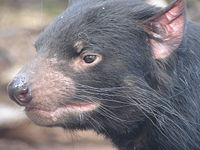Devils and Roadkill: Difference between revisions
From Santa Fe Institute Events Wiki
No edit summary |
No edit summary |
||
| Line 1: | Line 1: | ||
{{CSSS 2010 Santa Fe}} | {{CSSS 2010 Santa Fe}} | ||
[[Image:TDevil.jpg|200px|thumb|right|alt text]] | |||
* Next Meeting: Friday 3pm? | |||
==Impact of prey predictability on contact network dynamics of individual foragers== | |||
We are interested in using cellular automata/agent based modelling approaches to investigate how a predictable increase of prey density (from roadkill) impacts the contact network dynamics of a group of individual foragers (Tasmanian Devils). We are interested in how the frequency at which devils interact (and with whom) scales with the ratio of prey density on roads to background levels. [[(Gavin Fay)]] | |||
The context for this foraging work is that determining how supplementing the prey base (from roadkill) might impact the transmission dynamics of Devil Facial Tumour Disease (DFTD) among the devil population. | |||
Additional interests of ours are therefore related to modelling dynamics of infection within the network, which could also be connected with population dynamics models, and changes in life history traits (infected populations are now semelparous, with a large drop in age of sexual maturity). | |||
===Working group / interest== | |||
*[[(Gavin Fay)]] | |||
*[[(Megan Olsen)]] | |||
*[[(Joseph Gran)]] | |||
*[[(Vanessa Weinberger)]] | |||
*[[(Oana Carja)]] | |||
*[[(John Paul Gonzales)]] | |||
*[[(Julie Granka)]] | |||
*[[(Anne Johnson)]] | |||
==Background== | |||
Tasmanian Devils, the largest marsupial carnivore, are currently experiencing a dramatic reduction in population due to DFTD, a rather nasty infectious cancer which has become prevalent through much of the state. DFTD infection relies on transmission of infected cells from contact, most likely due to biting, which these critters do a lot of during mating and around prey carcasses. A hot conservation topic right now is forestry plans to build roads opening up a wilderness area in the north of the state to ecotourism opportunities. The devil population in this area has until now remained disease free. There are concerns that the road will increase the likelihood that DFTD will spread to the diseasse-free population: Devils are scavengers and frequently feed on roadkill, the creation of a road may then provide an opportunity for increased frequency of contact between infected and disease-free devils. It might be interesting to investigate how introducing a fixed-location source of additional prey items (ie a road) to a devil population would change the contact network for Devils, and then also to what extent the increased contact frequency would have to be to facilitate transmission of DFTD from an infected devil population to a disease-free one. | |||
==Methods/Approach== | |||
==Some recent (possibly relevant) papers on DFTD== | ==Some recent (possibly relevant) papers on DFTD== | ||
(to | (Warning: some may find images contained within these papers disturbing) | ||
[http://www.pnas.org/content/105/29/10023.full.pdf+html Jones et al. 2008. Life-history change in disease-ravaged Tasmanian devil populations] | |||
http://www.esajournals.org/doi/abs/10.1890/08-1763.1 McCallum et al. 2009. Transmission dynamics of Tasmanian devil facial tumor disease may lead to disease-induced extinction] | |||
[http://www3.interscience.wiley.com/journal/120695148/abstract?CRETRY=1&SRETRY=0 Hamede et al 2008] | |||
==Other Resources== | |||
[[http://www.roadkilltas.com/ Road Kill Tasmania, Maps of Roadkill Hotspots]] | |||
Revision as of 05:52, 11 June 2010
| CSSS Santa Fe 2010 |

- Next Meeting: Friday 3pm?
Impact of prey predictability on contact network dynamics of individual foragers
We are interested in using cellular automata/agent based modelling approaches to investigate how a predictable increase of prey density (from roadkill) impacts the contact network dynamics of a group of individual foragers (Tasmanian Devils). We are interested in how the frequency at which devils interact (and with whom) scales with the ratio of prey density on roads to background levels. (Gavin Fay)
The context for this foraging work is that determining how supplementing the prey base (from roadkill) might impact the transmission dynamics of Devil Facial Tumour Disease (DFTD) among the devil population. Additional interests of ours are therefore related to modelling dynamics of infection within the network, which could also be connected with population dynamics models, and changes in life history traits (infected populations are now semelparous, with a large drop in age of sexual maturity).
=Working group / interest
- (Gavin Fay)
- (Megan Olsen)
- (Joseph Gran)
- (Vanessa Weinberger)
- (Oana Carja)
- (John Paul Gonzales)
- (Julie Granka)
- (Anne Johnson)
Background
Tasmanian Devils, the largest marsupial carnivore, are currently experiencing a dramatic reduction in population due to DFTD, a rather nasty infectious cancer which has become prevalent through much of the state. DFTD infection relies on transmission of infected cells from contact, most likely due to biting, which these critters do a lot of during mating and around prey carcasses. A hot conservation topic right now is forestry plans to build roads opening up a wilderness area in the north of the state to ecotourism opportunities. The devil population in this area has until now remained disease free. There are concerns that the road will increase the likelihood that DFTD will spread to the diseasse-free population: Devils are scavengers and frequently feed on roadkill, the creation of a road may then provide an opportunity for increased frequency of contact between infected and disease-free devils. It might be interesting to investigate how introducing a fixed-location source of additional prey items (ie a road) to a devil population would change the contact network for Devils, and then also to what extent the increased contact frequency would have to be to facilitate transmission of DFTD from an infected devil population to a disease-free one.
Methods/Approach
Some recent (possibly relevant) papers on DFTD
(Warning: some may find images contained within these papers disturbing) Jones et al. 2008. Life-history change in disease-ravaged Tasmanian devil populations http://www.esajournals.org/doi/abs/10.1890/08-1763.1 McCallum et al. 2009. Transmission dynamics of Tasmanian devil facial tumor disease may lead to disease-induced extinction] Hamede et al 2008
